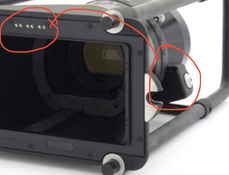Just an update on this... I did buy a shutter that was mentioned above by roman_K (actually I got two of them) and I went through the process of replacing the shutter on the 105mm lens that I have here.
It isn't horrible, but it is more than a non-mechanically-inclined person will prpobably want to go through. However, someone who knows how to do some camera servicing should be able to do it without too much difficulty. You need micro-screwdrivers, a good workspace (there are about miniture 30 screws involved), you need to be able to do some micro electronics soldering and desoldering. And, I guess, you need a stomach of steel to go into the abyss without any real guidance.
The basic information that I learned through this shutter swap process follows (which may only apply to the 105mm, but I suspect is correct for all the lenses):
1. Remove the "crash bar". Probably not needed, but it gives you a bit better access to the front shutter. Remove the front lens cell.
2. Unscrew the rear electrical contacts frame.
3. Desolder the electrical contacts frame from the leads that go towrds the lens. There are three wires. Make sure you track the wiring colors...
4. Remove the metal body mount casting. This was important for me because I couldn't get the rear cell to unscrew without applying a serious amount of torque to the cell and unless I had a specific spanner wrench fabricated (which is possible), I needed the rear cell to stick out so I could get it safely wrenched without damage.
5. Remove the rear lens cell.
6. Remove the lens retaining ring. Mine was secured with some thread lock, I used a bit of acetone to remove it and then it same off with a Copal 0 wrench. I had to get one from Ebay that had suitable dimensions (the old Rodenstock multi-wrench the many of us have is too fat to fit in thee cone). I'll put a link to what I used below.
7. Flip the lens over and desolder the brown connection to the solenoid.
8. Cut the black wire with enough of a lead so soldering will be possible.
9. Remove the aperture marking plate from the old shutter.
10. Remove a little plastic wedge on the very rim of the old shutter that interfaces with the solenoid (I think it is used to disable the solenoid for BULB setting, not 100% sure, but that appears to be what it does).
Now reverse the steps, but solder rather than desolder, etc.
11. Attach the aperture plate and the little plastic wedge.
12. Solder the brown lead to the solenoid.
13. Trim and solder the black lead and tape or otherwise insulate it. If I had some black coating plastidip or similar, that's what I would have used.
14. Place the shutter on the heloical and make sure it is oriented correctly.
15. Install the new shutter retaining ring.
16. Reinstall the rear lens cell.
17. Reinstall the rear lens mount casting.
18. Resolder the contacts on the electrtical contacts frame.
19. Reinstall the electrical contacts frame.
20. Reinstall the crash bar and front lens cell.
This is the shutter wrench that I used and it fits in the fairly snug space in the lens cone:
LULAND has been focusing on CNC precision machining for more than ten years. “Stable”but“flexible”is our philosophy. Large format lens wrench.
www.ebay.com
It's all swapped out and appears to be working... I have to take it out and test for infinity and adjust the helical if it is off (it might be, because when I was figuring out how things workled, I loosened the helical collar).
As soon as I have tested that, I'll be 100% done.
I think I have all the pieces for the old shutter, so I was thinking about either sending it to someone to rebuild or possibly learning how to do this myself. If I can get it rebuilt, I'll have a pair of backups ready for a future failure and there is no reason I can't keep the lenses running for a long time by swapping and repairing as needed.
One note, there is no reason you can't use a normal Copal 0 shutter as a replacement, but there are some differences... This shutter has no shutter open lever on it because you would fog film if you did that when the camera is loaded. It also has the electrcal leads that tie into the shutter. I'm not 100% sure what they do. I think they keep you from being able to open the shutter a second time on the same frame. So if you wanted to use a normal Copal 0, you probaly could, but you would have to be much more careful about how you use the lens to avoid double exposures or fogging the film, and of course, you would have to possibly only use the direct shutter release on the lens rather than the battery powered solenoid since it may not fully work without the contacts.













